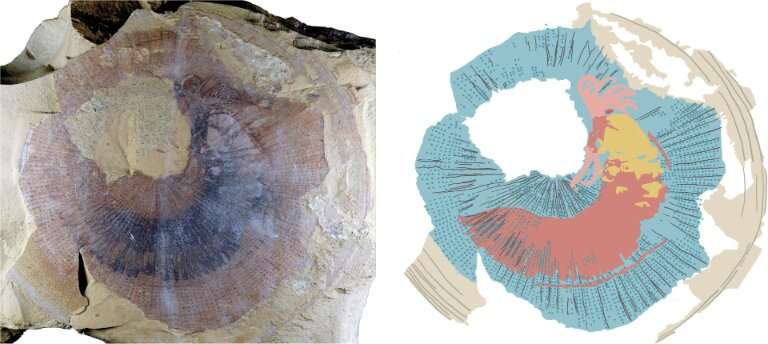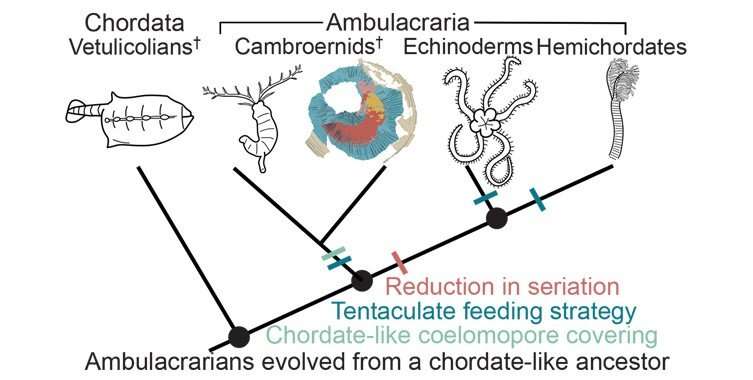This article has been reviewed according to Science X's editorial process and policies. Editors have highlighted the following attributes while ensuring the content's credibility:
fact-checked
peer-reviewed publication
trusted source
proofread
Rare fossils fill a gap in the evolution of major animal groups

Exceptionally well-preserved fossils from the Cambrian period have helped fill a gap in our understanding of the origin and evolution of major animal groups alive today.
A new analysis of fossils belonging to an extinct invertebrate called Rotadiscus grandis have helped place this species in the animal tree of life, revealing how some characteristics of living species may have evolved independently rather than originating in a single common ancestor.
Half a billion years ago, an unusual-looking animal crawled over the sea floor, using tentacles to pick up food particles along the way.
Known as Rotadiscus grandis, this animal lived during the Cambrian period when a burst of evolutionary activity is thought to have given rise to many of the major animal groups we see today.
The ancient remains of Rotadiscus were first discovered over 30 years ago, but the incomplete specimens made it challenging to determine their evolutionary significance.
Now, a new study published in Current Biology describes Rotadiscus grandis in far more detail after rare, exceptionally preserved fossils were unearthed from the Chengjiang biota in Yunnan Province in China. The 518-million-year-old fossils have shone a new light on the evolution of early members of major animal groups.
Dr. Imran Rahman, a principal researcher at the Museum and lead author of the study, says, "Rotadiscus isn't like anything we see alive today. It's why I find these kinds of weird wonders so fascinating."
"Some of the features that we might have assumed were present in the common ancestor of major animal groups, such as a post-anal tail, we found actually evolved independently. Cambrian fossils are fundamental to understanding these kinds of processes."

Why has it been difficult to describe Rotadiscus?
Over half a billion years ago, the Cambrian period saw an extraordinary burst in evolution giving rise to an incredible diversity of life. Early members of many major animal groups alive today appeared during this time, including the chordates to which vertebrates belong.
Many animals from this period possessed unique anatomies that look very different to anything seen today. But the patchiness of the fossil record often makes deciphering what these species are or where they fit into the tree of life challenging for paleontologists.
In the past, Rotadiscus and its closest fossil relatives have been placed in a number of different groups, including the sea cucumbers and jellyfish. But the new fossils of Rotadiscus from Chengjiang are helping to clear this up.
The Chengjiang biota is famous for its exceptionally preserved Cambrian fossils. The likely reason is that these animals were buried by a mudflow very rapidly while they were still alive, entombing them and preventing decay by bacteria and scavenging by other animals.
The new Rotadiscus fossils are no exception, as their extraordinary preservation has revealed structures in more detail than had previously been observed, such as traces of possible nerves in the tentacles and a new double spiral structure.
"We weren't sure what type of animal Rotadiscus was, and that made it hard to use as a tool for understanding the diversity of life," says Imran.
"So our main goal in this paper was to figure out what Rotadiscus was and then uncover its evolutionary significance."
Why are these Rotadiscus fossils important?
The exceptional preservation of the Rotadiscus specimens from the Chengjiang biota meant scientists could identify new features to help determine the evolutionary significance of the animal.
Researchers analyzed 330 features from about 60 different groups of extinct and extant animals, looking for similarities that could suggest a link. Rotadiscus was determined to be a very early member of a group of animals called the ambulacrarians, which contains acorn worms and echinoderms like starfish and sea urchins.
The new evolutionary tree including Rotadiscus and other fossils has helped the researchers reconstruct the evolution of major animal traits. One feature that was of particular significance was the presence of a tail extending posteriorly to the anus.
Scientists originally believed that a post-anal tail was present in the common ancestor of all fish and acorn worms. However, as Rotadiscus lacks a post-anal tail it now seems that this trait may have evolved independently within these different groups.
This process is known as convergent evolution, where the same feature evolves separately multiple times, often in response to similar environmental or ecological pressures.
"Through our analysis, we can fill an evolutionary gap with Rotadiscus and its relatives," says Imran. "This is important because one of the goals for paleontologists is to try to understand the tree of life and how things are related to one another."
"But it's also exciting because it allows us to better understand the evolution of other major animal groups, including the one that includes humans. This also helps to reinforce the critical importance of fossils, as the predictions we made in this analysis could not have been made based on living animals alone."
"It's only by incorporating these unfathomable, weird wonders into our evolutionary trees that we can start to get a better understanding of the origin and early evolution of major animal groups."
More information: Yujing Li et al, Cambrian stem-group ambulacrarians and the nature of the ancestral deuterostome, Current Biology (2023). DOI: 10.1016/j.cub.2023.04.048
Journal information: Current Biology
Provided by Natural History Museum
This story is republished courtesy of Natural History Museum. Read the original story here.





















